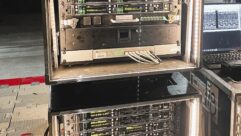
IEM Lawsuits Waiting To Happen?
Maybe it was inevitable that a Louisiana iPod owner is suing Apple for hearing damage allegedly caused by the device’s earbuds and their ?lack? of adequate warnings. Is it just a matter of time before the same fate befalls manufacturers and resellers of in-ear monitors (IEMs) used in pro AV applications?
Any company with sales of 42 million units from a single product in five years is likely to be a target for lawsuits — especially if that company uses a piece of fruit in its logo. So maybe it was inevitable that a Louisiana iPod owner is suing Apple for hearing damage allegedly caused by the device’s earbuds and their “lack” of adequate warnings.
Is it just a matter of time before the same fate befalls manufacturers and resellers of in-ear monitors (IEMs) used in pro AV applications? IEMs have been gaining popularity in the last decade, and lower prices and greater selection have made them accessible to all levels of musicians and other users.
IEMs make sense. Stage instruments make a lot of noise, and floor monitor loudspeakers only add to the overall level. In order for vocalists to hear the floor monitor, they often need to be turned up so loud that feedback becomes a problem. IEMs can greatly reduce stage volume by replacing floor monitors, and can eliminate feedback issues.
There are reasons why makers of these devices may be as exposed to liability claims as the big Apple. Granted, pro applications and product sales are likely with only a fraction of the general consumer base using earbuds with MP3 players like the iPod. But the way IEMs are bought and used in the professional and prosumer markets may actually present a greater chance that end-users will blame their own irresponsibility on the manufacturer or system installer.
Low-cost earbuds provide less acoustic isolation than more expensive, higher quality ones. Better isolation means you don’t have to turn it up as loud to hear over the ambient stage wash or crowd noise. Custom-molded ear buds are best, but they can cost $1,000 or more. On the other hand, you can buy earbuds for less than $100, but they won’t provide isolation — tempting the user to crank up the volume to dangerous levels to get above the ambient noise floor. Sure, there are some equipment purchases where it’s okay to save money buying low-end gear. In those cases, the only consequence might be a lower-quality experience. But the money saved in buying low-end IEMs may be more than offset in potential hearing damage. Beyond the medical costs, hearing damage can rob people of their livelihoods. If that happens, lawsuits may be aimed at the AV integrators who provided the equipment.
If you use or spec IEMs, protect yourself and our industry from frivolous lawsuits by choosing quality equipment. Better yet, ask your end-users to sign a waiver that says they’ve been properly trained in using IEMs, and understand the danger of hearing loss if the equipment is used improperly. Otherwise, you could be next in the long line of liability.










